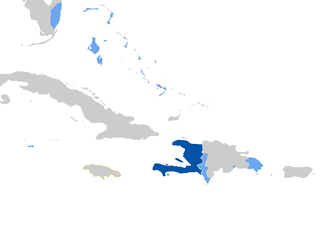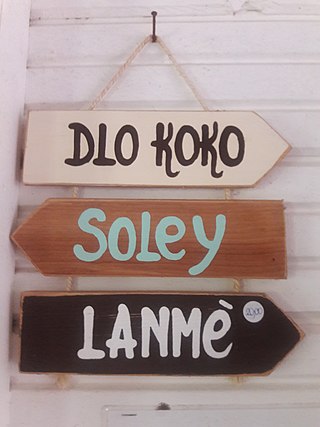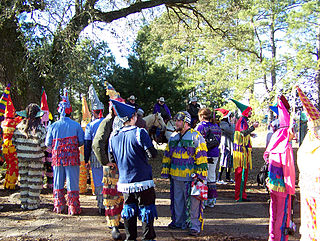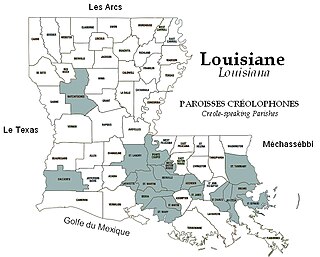A pidgin, or pidgin language, is a grammatically simplified means of communication that develops between two or more groups of people that do not have a language in common: typically, its vocabulary and grammar are limited and often drawn from several languages. It is most commonly employed in situations such as trade, or where both groups speak languages different from the language of the country in which they reside.

A creole language, or simply creole, is a stable natural language that develops from the process of different languages simplifying and mixing into a new form, and then that form expanding and elaborating into a full-fledged language with native speakers, all within a fairly brief period. While the concept is similar to that of a mixed or hybrid language, creoles are often characterized by a tendency to systematize their inherited grammar. Like any language, creoles are characterized by a consistent system of grammar, possess large stable vocabularies, and are acquired by children as their native language. These three features distinguish a creole language from a pidgin. Creolistics, or creology, is the study of creole languages and, as such, is a subfield of linguistics. Someone who engages in this study is called a creolist.

Tok Pisin, often referred to by English speakers as New Guinea Pidgin or simply Pidgin, is a creole language spoken throughout Papua New Guinea. It is an official language of Papua New Guinea and the most widely used language in the country. However, in parts of the southern provinces of Western, Gulf, Central, Oro, and Milne Bay, the use of Tok Pisin has a shorter history and is less universal, especially among older people.
Sango is the primary language spoken in the Central African Republic and also the co-official language of the country. It is used as a lingua franca across the country and had 450,000 native speakers in 1988. It also has 1.6 million second language speakers.

Haitian Creole, or simply Creole, is a French-based creole language spoken by 10 to 12 million people worldwide, and is one of the two official languages of Haiti, where it is the native language of the vast majority of the population. Northern, Central, and Southern dialects are the three main dialects of Haitian Creole. The Northern dialect is predominantly spoken in Cap-Haïtien, Central is spoken in Port-au-Prince, and Southern in the Cayes area.

Antillean Creole is a French-based creole that is primarily spoken in the Lesser Antilles. Its grammar and vocabulary include elements of French, Carib, English, and African languages.
In linguistics, relexification is a mechanism of language change by which one language changes much or all of its lexicon, including basic vocabulary, with the lexicon of another language, without drastically changing the relexified language's grammar. The term is principally used to describe pidgins, creoles, and mixed languages.
Decreolization is a postulated phenomenon whereby over time a creole language reconverges with the lexifier from which it originally derived. The notion has attracted criticism from linguists who argue there is little theoretical or empirical basis on which to postulate a process of language change which is particular to creole languages.

A French creole, or French-based creole language, is a creole for which French is the lexifier. Most often this lexifier is not modern French but rather a 17th- or 18th-century koiné of French from Paris, the French Atlantic harbors, and the nascent French colonies. This article also contains information on French pidgin languages, contact languages that lack native speakers.

A capuchon is a cone-shaped ceremonial hat worn during the Mardi Gras celebration in the Cajun areas of southern Louisiana, known as the Courir de Mardi Gras. The rural celebration is based on early begging rituals, similar to those still celebrated by mummers, wassailers and celebrants of Halloween. As Mardi Gras is the celebration of the final day before Lent, celebrants drink and eat heavily, but dress in costume, ostensibly to protect their identities.

Louisiana Creoles are a Louisiana French ethnic group descended from the inhabitants of colonial Louisiana before it became a part of the United States during the period of both French and Spanish rule. They share cultural ties such as the traditional use of the French, Spanish, and Creole languages and predominant practice of Catholicism.

Cajun English, or Cajun Vernacular English, is a dialect of American English spoken by Cajuns living in Southern Louisiana. Cajun English is significantly influenced by Louisiana French, the historical language of the Cajun people, a subset of Louisiana Creoles — although many today prefer not to identify as such — who descend largely from the Acadian people expelled from the Maritime provinces during Le Grand Dérangement.
A lexifier is the language that provides the basis for the majority of a pidgin or creole language's vocabulary (lexicon). Often this language is also the dominant, or superstrate language, though this is not always the case, as can be seen in the historical Mediterranean Lingua Franca. In mixed languages, there are no superstrates or substrates, but instead two or more adstrates. One adstrate still contributes the majority of the lexicon in most cases, and would be considered the lexifier. However, it is not the dominant language, as there are none in the development of mixed languages, such as in Michif.

A tasse à café is a cup, generally of white porcelain and of around 120 ml (4 fl oz), in which coffee is served. It is also sometimes used to serve small portions of rich drinks, such as hot chocolate.
The nasal palatal approximant is a type of consonantal sound used in some oral languages. The symbol in the International Phonetic Alphabet that represents this sound is ⟨j̃⟩, that is, a j with a tilde. The equivalent X-SAMPA symbol is j~, and in the Americanist phonetic notation it is ⟨ỹ⟩.
Haitian French is the variety of French spoken in Haiti. Haitian French is close to standard French. It should be distinguished from Haitian Creole, which is not mutually intelligible with French.
Brian James Costello is an American historian, author, archivist and humanitarian. He is an 11th generation resident of New Roads, Louisiana, seat of Pointe Coupee Parish. He is three-quarters French and one-quarter Italian in ancestry.

Louisiana French is an umbrella term for the dialects and varieties of the French language spoken traditionally by French Louisianians in colonial Lower Louisiana. As of today Louisiana French is primarily used in the state of Louisiana, specifically in its southern parishes.

Annegret Bollée was a German linguist and Professor Emeritus at the University of Bamberg, specializing in Romance linguistics and creole languages.












